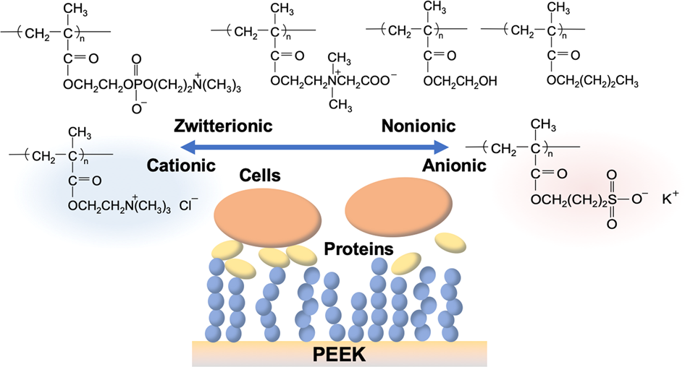Our official English website, www.x-mol.net, welcomes your
feedback! (Note: you will need to create a separate account there.)
Photoinduced self-initiated graft polymerization of methacrylate monomers on poly(ether ether ketone) substrates and surface parameters for controlling cell adhesion
Polymer Journal ( IF 2.3 ) Pub Date : 2020-03-09 , DOI: 10.1038/s41428-020-0318-9 Kazuhiko Ishihara , Satoshi Yanokuchi , Kyoko Fukazawa , Yuuki Inoue
Polymer Journal ( IF 2.3 ) Pub Date : 2020-03-09 , DOI: 10.1038/s41428-020-0318-9 Kazuhiko Ishihara , Satoshi Yanokuchi , Kyoko Fukazawa , Yuuki Inoue

|
One of the super engineering plastics, poly(ether ether ketone) (PEEK), was functionalized by photoinduced self-initiated graft polymerization of various methacrylate monomers. Anionic, cationic, zwitterionic, nonionic hydrophilic, and nonionic hydrophobic polymer layers were formed onto PEEK substrates. Physical and chemical surface characterizations of the resultant polymer-grafted PEEK substrates were performed through measurements of their surface free energies and ζ potentials. The values of these parameters varied in the ranges of 39–71 mJ/m 2 and −69 to 46 mV, respectively. These parameters reflected the chemical structures of the grafted polymers. To understand the effects of these surface parameters on cell adhesion behavior at the substrate surface, the amount of fibronectin adsorbed on the plasma-contacting surface and the density of fibroblast cells adhered to the surface were determined. The adherent cell density showed a good linear correlation with the amount of fibronectin adsorbed on the plasma-contacting surface. The polymer surface with zero ζ potential showed a lower adsorbed fibronectin density. Both anionic and cationic polymer layers had increased cell adhesion compared with that on the original PEEK substrate, whereas the zwitterionic polymer layers significantly prevented cell adhesion. In conclusion, grafting zwitterionic polymers onto a PEEK substrate is anticipated to be useful in the development of a biomedical PEEK substrate. To obtain functionalization of super-engineering plastic, poly(ether ether ketone) (PEEK) substrate, photoinduced self-initiated graft polymerization of several kinds of functional methacrylate was carried out. Graft polymerization proceeded well, and 50–250 nm in thickness graft polymer layers were generated on the PEEK substrate. Surface characteristics such as surface free energy and surface ζ potential on the polymer-grafted PEEK substrate were corresponded to the chemical structure of the graft polymers. Cell attachment on the polymer-grafted PEEK substrate was examined. The surface ζ potentials of the polymer-grafted PEEK substrates governed the cell adhesion density.
中文翻译:

甲基丙烯酸酯单体在聚(醚醚酮)基材上的光诱导自引发接枝聚合和用于控制细胞粘附的表面参数
其中一种超级工程塑料聚(醚醚酮)(PEEK)通过各种甲基丙烯酸酯单体的光诱导自引发接枝聚合进行了功能化。在 PEEK 基材上形成阴离子、阳离子、两性离子、非离子亲水性和非离子疏水性聚合物层。通过测量其表面自由能和 ζ 电位,对所得聚合物接枝的 PEEK 基材进行物理和化学表面表征。这些参数的值分别在 39–71 mJ/m 2 和 -69 到 46 mV 的范围内变化。这些参数反映了接枝聚合物的化学结构。为了了解这些表面参数对基底表面细胞粘附行为的影响,测定吸附在血浆接触表面上的纤连蛋白的量和粘附在表面上的成纤维细胞的密度。贴壁细胞密度与吸附在血浆接触表面上的纤连蛋白量呈良好的线性相关性。零 ζ 电位的聚合物表面显示出较低的吸附纤连蛋白密度。与原始 PEEK 基材相比,阴离子和阳离子聚合物层均增加了细胞粘附,而两性离子聚合物层显着阻止了细胞粘附。总之,预计将两性离子聚合物接枝到 PEEK 基材上可用于生物医学 PEEK 基材的开发。为了获得超级工程塑料、聚醚醚酮(PEEK)基材的功能化,进行了几种功能性甲基丙烯酸酯的光诱导自引发接枝聚合。接枝聚合进行得很好,并且在 PEEK 基材上产生了 50-250 nm 厚的接枝聚合物层。聚合物接枝的 PEEK 基材上的表面特征如表面自由能和表面 ζ 电位与接枝聚合物的化学结构相对应。检查了聚合物接枝的 PEEK 基材上的细胞附着。聚合物接枝的 PEEK 基材的表面 ζ 电位控制着细胞粘附密度。聚合物接枝的 PEEK 基材上的表面特征如表面自由能和表面 ζ 电位与接枝聚合物的化学结构相对应。检查了聚合物接枝的 PEEK 基材上的细胞附着。聚合物接枝的 PEEK 基材的表面 ζ 电位控制着细胞粘附密度。聚合物接枝的 PEEK 基材上的表面特征如表面自由能和表面 ζ 电位与接枝聚合物的化学结构相对应。检查了聚合物接枝的 PEEK 基材上的细胞附着。聚合物接枝的 PEEK 基材的表面 ζ 电位控制着细胞粘附密度。
更新日期:2020-03-09
中文翻译:

甲基丙烯酸酯单体在聚(醚醚酮)基材上的光诱导自引发接枝聚合和用于控制细胞粘附的表面参数
其中一种超级工程塑料聚(醚醚酮)(PEEK)通过各种甲基丙烯酸酯单体的光诱导自引发接枝聚合进行了功能化。在 PEEK 基材上形成阴离子、阳离子、两性离子、非离子亲水性和非离子疏水性聚合物层。通过测量其表面自由能和 ζ 电位,对所得聚合物接枝的 PEEK 基材进行物理和化学表面表征。这些参数的值分别在 39–71 mJ/m 2 和 -69 到 46 mV 的范围内变化。这些参数反映了接枝聚合物的化学结构。为了了解这些表面参数对基底表面细胞粘附行为的影响,测定吸附在血浆接触表面上的纤连蛋白的量和粘附在表面上的成纤维细胞的密度。贴壁细胞密度与吸附在血浆接触表面上的纤连蛋白量呈良好的线性相关性。零 ζ 电位的聚合物表面显示出较低的吸附纤连蛋白密度。与原始 PEEK 基材相比,阴离子和阳离子聚合物层均增加了细胞粘附,而两性离子聚合物层显着阻止了细胞粘附。总之,预计将两性离子聚合物接枝到 PEEK 基材上可用于生物医学 PEEK 基材的开发。为了获得超级工程塑料、聚醚醚酮(PEEK)基材的功能化,进行了几种功能性甲基丙烯酸酯的光诱导自引发接枝聚合。接枝聚合进行得很好,并且在 PEEK 基材上产生了 50-250 nm 厚的接枝聚合物层。聚合物接枝的 PEEK 基材上的表面特征如表面自由能和表面 ζ 电位与接枝聚合物的化学结构相对应。检查了聚合物接枝的 PEEK 基材上的细胞附着。聚合物接枝的 PEEK 基材的表面 ζ 电位控制着细胞粘附密度。聚合物接枝的 PEEK 基材上的表面特征如表面自由能和表面 ζ 电位与接枝聚合物的化学结构相对应。检查了聚合物接枝的 PEEK 基材上的细胞附着。聚合物接枝的 PEEK 基材的表面 ζ 电位控制着细胞粘附密度。聚合物接枝的 PEEK 基材上的表面特征如表面自由能和表面 ζ 电位与接枝聚合物的化学结构相对应。检查了聚合物接枝的 PEEK 基材上的细胞附着。聚合物接枝的 PEEK 基材的表面 ζ 电位控制着细胞粘附密度。











































 京公网安备 11010802027423号
京公网安备 11010802027423号